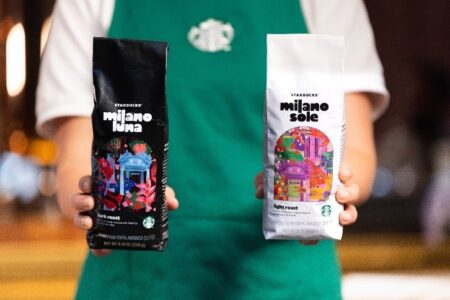Starbucks Q3 2023 net revenues rise 12% to USD $12 billion

Image credit: Starbucks Coffee
Starbucks Corporation (Nasdaq: SBUX) yesterday reported financial results for its 13-week fiscal third quarter ended 2 July 2023 announcing double-digit net revenue and global comparable-store sales growth. GAAP results in fiscal 2023 and fiscal 2022 include items that are excluded from non-GAAP results.
Consolidated net revenues were USD $9.2 billion, an increase of 12% from the prior year, or 14%, inclusive of more than 1% unfavourable impact from foreign currency translation.
The Seattle, Washington-based company disclosed that global comparable-store sales increased 10%, primarily driven by a 5% increase in comparable transactions and a 4% increase in average ticket. North America and U.S. comparable-store sales increased 7%, driven by a 6% increase in average ticket and a 1% increase in comparable transactions. International comp-store sales increased 24%, driven by a 21% increase in comparable transactions and a 2% increase in average ticket. Within China, comp-store sales surged 46%, driven by a 48% increase in comparable transactions and a 1% decline in average ticket.
GAAP operating margin of 17.3% increased from 15.9% in the prior year, primarily driven by sales leverage, pricing and productivity improvement. This expansion was partially offset by previously committed investments in labour, including enhanced store partner wages and benefits and higher general and administrative costs related to Starbucks’ Reinvention Plan. GAAP earnings per share of $0.99 grew 25% over the prior year.
Non-GAAP operating margin of 17.4% increased from 16.9% in the prior year. Non-GAAP earnings per share of $1.00 grew 19% over prior year
Net revenues for the North America segment grew 11% over Q3 FY22 to $6.7 billion in Q3 FY23, primarily driven by a 7% increase in company-operated comparable store sales, driven by a 6% increase in average ticket and a 1% increase in comparable transactions, net new company-operated store growth of 4% over the past 12 months, as well as strength in our licensed store sales.
Operating income increased to $1.5 billion in Q3 FY23 compared to $1.3 billion in Q3 FY22. Operating margin of 21.7% contracted from 22.0% in the prior year, primarily driven by previously committed investments in labour, including enhanced store partner wages and benefits as well as increased spending on partner training. This contraction was partially offset by strategic pricing, productivity improvement and sales leverage.
Net revenues for the International segment grew 24% over Q3 FY22 to $2.0 billion in Q3 FY23, primarily driven by a 24% increase in comparable store sales, net new company-operated store growth of 11% over the past 12 months, as well as growth in our licensed store revenue including higher product sales and royalty revenues. These increases were partially offset by approximately 5% unfavourable impact from foreign currency translation.
Operating income increased to $374.5 million in Q3 FY23 compared to $135.3 million in Q3 FY22. Operating margin of 19.0% expanded from 8.5% in the prior year, primarily driven by sales leverage including lapping mobility restrictions in China and prior year amortization expenses. This expansion was offset by digital investments and inflationary pressures.
Net revenues for the Channel Development segment decreased 6% over Q3 FY22 to $448.8 million in Q3 FY23, driven by a decline in revenue in the Global Coffee Alliance.
Operating income increased to $208.0 million in Q3 FY23 compared to $191.7 million in Q3 FY22. Operating margin of 46.3% expanded from 40.0% in the prior year, primarily driven by growth in our North American Coffee Partnership joint venture income and mix shift.
Noting the results, Laxman Narasimhan, CEO, said, “Our strong third quarter results point to all-around momentum in the business and reflect the significant progress we are making against our Reinvention Plan. Our results were also amplified by the distinctive competitive advantages that set us apart in the market.”
Starbucks opened 588 net new stores in Q3, crossing the 37,000 store count threshold globally, ending the period with 37,222 stores: 51% company-operated and 49% licensed. At the end of Q3, stores in the U.S. and China comprised 61% of the company’s global portfolio, with 16,144 and 6,480 stores in the U.S. and China, respectively.
Starbucks Rewards loyalty program 90-day active members in the U.S. increased to 31.4 million, up 15% year-over-year.
In May, Starbucks opened the first store in Paraguay, entering the 24th market in Latin America and the Caribbean and 86th market globally. The company also opened its first store in Rome, in May, in partnership with Percassi, its Italian licensee partner. In June, the company announced plans to expand their farm capability beyond coffee to include a new sustainability learning and innovation lab at Hacienda Alsacia in Costa Rica, the global agronomy headquarters for research and development.
Starbucks executives said the company’s financial results and long-term growth model will continue to be driven by new store openings, comparable store sales growth and operating margin management.
Rachel Ruggeri, CFO, commented, “I am pleased with our third quarter performance, which beat our expectations, including our International segment. Our performance was bolstered by the progress we are making against our strategies, specifically our Reinvention Plan, and its unfolding into tangible financial results, as we delivered earnings growth of 19% well above our revenue growth of 12%.” She added, “the momentum we have built and strength we are seeing globally, gives us the confidence and optimism to close our fiscal year strong.”
Seeking Alpha analyst Dilantha De Silva stated that he is skeptical of Starbucks’ “ambitious plan to achieve 7%-9% annual comparable-store sales growth through fiscal 2025.” However, he did note that the company has room to grow in the U.S., especially in smaller cities that have yet to be explored by the coffee chain. He added, “China is considered one of the biggest markets for tea, but there are clear signs of a growing coffee culture in the country. This is an opportunity for Starbucks.”



